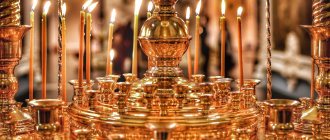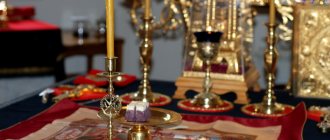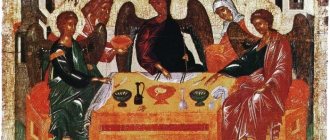The temple is a special place. You can come there just like that, in order to pray in silence and solitude. To escape from our noisy world with its endless rush and bustle. Pray in front of the icons, light candles. In general, at least for a few minutes, detach yourself from vanity. And catch a familiar and some kind of nagging smell. What does the old church smell like?
Wax candle
What does the church smell like, what candles emit a delicate and pleasant aroma that you want to inhale again and again? Of course, wax. Wax is considered the purest substance. A candle is a small sacrifice to God from a person. Is it really possible to sacrifice something bad to God? No, He is supposed to give the best. And not as in the proverb well known to all of us: “You, God, are worthless to me.” And this attitude towards the Creator is fundamentally wrong. He does not forget to take care of us: he wakes us up in the morning, allowing us to see a new day, responds to our requests, helps and does not leave us in sorrow. Why don't we try to give Him the best?
Okay, let's leave the lyrics. Everything is always pure to God - this is a truth established from ancient times. Clean incense for worship, clean candles, clean oil. In general, everything is the best. Other candles contain impurities and cannot be called pure. In addition to religious motivation, there is also a purely everyday one. Wax does not pollute the air, it emits a pleasant aroma, and most importantly, it does not smoke to such an extent as to spoil temple frescoes and icons.
A candle is a symbol of the burning of human souls with faith. Symbol of soul fire. A visible sacrifice to God from His sinful servants. Someone will say that a wax candle is not cheap. Can sacrifice really be cheap? It is done from the heart. When a person does something from the heart, wants to give a wonderful gift to a loved one, for example, he does not consider the costs. A candle is much cheaper than some decoration for a loved one.
Another smell
It is intangible and cannot be felt with the nose. Only with the soul. What else does the church smell like? Calm and serenity. It’s like in our parents’ house, where we are welcomed and loved. Where you can completely relax, feel safe and trust your loved ones. It’s the same in church, only there we trust the Lord God himself.
Ceresin candles
Unlike waxy ones, they consist of a waxy substance. And they are not clean. And due to the fact that ceresin candles are a storehouse of impurities, they are also not very useful for use.
What's wrong with these candles? First of all, they smell bad. And if now, answering the question “what does the church smell like?”, only pleasant smells are remembered, then after communicating with “fake” candles they will disappear. And this is just the minimum of troubles. The worst thing is that these candles smoke a lot. And thus they spoil the beautiful temple paintings and pollute the icons.
Yes, they are cheap. But the quality leaves much to be desired. Why are they being sold, another person will wonder. Alas, the concept of benefit exists everywhere. And other parishes are not spared this word. We will not develop this idea in order to avoid condemnation. Let's just keep in mind that nothing better than wax candles has yet been invented.
Types of candles
Church candles come in two types - wax and with an admixture of ceresin. Ceresin is not pure wax, but a waxy substance with various impurities. And how are these candles different? And this is discussed in detail in the next subsection.
Confirmation
Anyone who has participated in this sacrament at least once knows what the church smells like, except incense and wax. It smells like peace there. And thus, calm, serene, not tolerant of fuss, which is so lacking outside the gates of the temple. And myrrh - oil with the addition of various incense.
As a rule, the smell of this oil is very pleasant and delicate. When can you encounter him? At the moment of anointing. This happens at the evening service, when the priest draws a cross on the forehead of the parishioner in oil. This is a very rough explanation, but it is made so that it is at least a little clear what anointing is.
And the ritual is as follows: the believer venerates the festive icon standing in the center of the temple, closer to the pulpit. The priest, in turn, stands facing this icon, also in the center of the temple. After the person has kissed the icon, he approaches the priest. And he performs the rite of Confirmation. This aromatic oil is then rubbed all over your face.
What is incense used for?
According to the biblical Book of Tobit, incense signifies the power to drive away evil spirits (Tob. 8:2-3).
The chopping of incense is performed by a priest or deacon. For this, a censer and burning coal are used. Before censing, the priest blesses the censer and says a prayer:
“We offer the censer to You, Christ our God, into the stench of the spiritual fragrance, even as we receive you into Your heavenly mental altar, bestow upon us the grace of Your Most Holy Spirit.”
Incense is a sacrifice (offering) to God, incense smoke signifies the presence and fragrance of the grace of the Holy Spirit. Filling the entire space of the temple, it reminds Christians of the invisible presence of God. The smoke from incense during the morning service resembles the cloud that covered the Old Testament tabernacle.
“We bring oil, wax and incense to the temple: oil - in the image of Divine mercy; wax, secreted from many flowers, in the image of the all-perfect offering and our universal sacrifice; incense - in the image of Divine love, taught to everyone, also in the image of the fragrance of the Holy Spirit" (St. Simeon of Thessalonica, 15th century).
It's so easy to commit sins
Let us remember how Krug sings: “The old church smells of wax, I can’t remain silent. It’s so easy to commit sins...”
What's next, who will remember? “But it’s not easy to atone.” The long-deceased singer very accurately noted. Sin enters us in tons, and leaves us with great difficulty, barely. And how do we atone for our sins? First of all, repentance. And not only in words. We came to confession, listed our sins, the priest read a prayer of absolution over us and...? And went on sinning. Do the same things you repented of. What is the point of such a confession, the question arises.
The meaning of confession is true repentance. And it implies renunciation of sin. Rethinking your own life, when a person comes to the realization that everything! I don’t want to live like this anymore and do this and that. This is the meaning of repentance, in avoiding sin and voluntarily abandoning it.
When we sincerely repent and ask for forgiveness, then we want to make at least a small contribution to God. And we wonder what we can give to the One who gives us everything? Light a candle, pray from the heart, thank you from the heart. This is quite possible for everyone.
How to use blessed oil?
The benefit from the use of consecrated oil will be, first of all, for every true believer Christian. The Apostle Paul truly stated that everything goes well for the believer. It is no coincidence that consecrated oil is credited with miraculous powers, but, of course, it is not so much the oil itself that heals, but prayers and the power of faith.
Blessed oil will especially quickly help those who live the life of the Church and do not miss Communion and Confession. After the service, when reading the house of prayer before going to bed, it is advised to anoint yourself with the consecrated oil.
The oil should be applied crosswise from the right side to the left, directly crossing the sore spot. After application, the oil can be rubbed for better absorption. The oil is applied either using a small brush specially purchased for this purpose, or with a candle wick.
Superstitions
Sometimes a person is perplexed: although I’m not in church, it smells like incense. Indeed, this rarely happens. There is no need to be afraid of this. In fact, the body sometimes tends to wishful thinking. The so-called “program glitch”. Let's say someone hasn't eaten sausage for a long time and really wants to eat it. And it seems to him that the apartment smells of sausage, although there is no trace of it in the refrigerator, and no one can cut it at the moment. This is a game of the body, do not pay attention.
It's the same here. People begin to panic and attribute supernatural explanations to this. Even to the point of warning of one's own demise. All this is nonsense, the real one. You should not look for mystical meaning in something where there is none.
In general, there is no need to connect the church and mysticism. God will never give a person what he cannot bear. As one nun said when people started talking to her about being afraid to see or hear something otherworldly: “Well, keep your pocket wider.”
Pointless and merciless
The husband comes home and the wife greets him. She catches a strange smell and thinks: “Why does my husband smell like church? Oh, bad luck. Something will happen. He will probably die."
Or maybe the spouse went to the nearest church after work to light a candle. He hadn’t been there for a long time, he was drawn there. Is your husband an unbeliever? I went into the store and ran into some guy. And this guy turned out to be an altar boy. And I was already saturated with the smell of church. So I slightly impregnated my husband. So, dear ladies, there is no need to bury your spouse ahead of time and start stressing yourself out. There is always an explanation for everything. And it’s better to approach the other half with a question about his last places of visit than to rack his brains over it.
And briefly about what not to do. It's believing old wives' tales. Sometimes you go into a temple, and there, by the candlesticks, are sharp-eyed grannies. They see everything, they notice everything. And they begin to hiss after him: “I took the candle with my left hand, what a cursed woman. You can’t light candles with your left hand, it’s a sin. And you can’t approach the icon in trousers, God will punish you. And his heels rattle like unclean hooves.” Sounds familiar, right? So, the politics of these grandmothers has nothing to do with Orthodoxy. What are they doing at the temple then, being absolutely illiterate in this matter? They notice the shortcomings of others and teach them about life. You should approach this with humor, but under no circumstances should you be scared or think anything stupid.
How to store blessed oil?
Blessed oil is one of the most revered and protected Shrines of Orthodoxy, therefore bottles with oil should be stored in the appropriate place - next to home icons. Oil should not be placed next to medicines, cosmetics, or in refrigerators.
The result of a trip to distant Holy places is often the acquisition of numerous rare and especially healing consecrated oils from the relics. Such unique oils cure illnesses surprisingly quickly, but their volume is not so large that you can distribute the oil to everyone you know and those who are sick.
Diveyevo traditions allow in such cases to prepare a clean bottle, fill it with simple vegetable oil and, through accompanying prayers, consecrate it for donation. Prayers over the prepared composition must certainly include an appeal to the Mother of God, the prayer “Our Father...” and a prayer word to the saint from whose relics your oil is consecrated.
Let's summarize
So, we found out that the old church smells of wax, incense and peace. Let's remember again what it is.
Wax is an environmentally friendly material obtained as a result of the work of bees. The wax is used to make real, fragrant candles for religious services.
Frankincense is an aromatic tree resin. It is used as the main attribute during censing, and therefore in the service. For censing is carried out during worship. There are three types of incense: Arabian, Somali and Indian. Its smell is sweet, with delicate hints of lemon.
Miro is an incense oil. Used at services to perform the rite of Confirmation.
Church incense
The Gospel testifies that the Magi brought gold, incense and myrrh to the Savior. If everything is relatively clear with the first gift, then the next one raises the question: how does myrrh differ from frankincense? And why did the pilgrims from the East offer incense to the newborn God-Infant - as to God, and myrrh - as to a mortal man?
In the Old Testament, incense was one of the components of incense burned in the temple - incense, the use of which in everyday life was strictly prohibited. Incense itself could also be used for worldly purposes: for healing, aromatizing the air in the home, or even as a perfume. The incense, in addition to incense, included stakti, onikh and halvan. Stacti, according to many interpreters, is myrrh (myrrh) - the resin of the myrrh tree. Halvan is also a resin extracted from a plant of the Ferula genus. Onikh is a substance of more unexpected origin: an extract from a certain type of mollusk. Thus, the Old Testament incense can be compared with modern incense, which is based on tree resin, supplemented with aromatic substances of various origins.
Frankincense and myrrh
Both frankincense and myrrh are incense that came to us from eastern countries: Arabia, Egypt, India. They were once highly valued. Initially
they were the resin of trees of certain species. In the east, boswellia resin, an evergreen southern tree, was and is most often used to make incense. There is a version that instead of imported boswellia resin, which is too expensive in the Holy Land, the more affordable juice of a local Mediterranean shrub, cistus, could be used. Myrrh was extracted from another evergreen tree - commiphora. Over time, myrrh began to be called a liquid incense with a “church” aroma. In pre-revolutionary texts the lyrical name “dewy incense” is found. This was the name given to incense made from the resin of the styrax tree. Styrax (dewy) incense was cheaper than boswellian incense and had a pleasant, but somewhat irritating odor. In Rus', since ancient times, incense has been flavored with the help of aromatic herbs - in particular, anise and thyme (thyme), called Bogorodskaya grass, as well as honey.
Nowadays, incense can be either natural or containing artificial components. The most common option in our country is natural resin with the addition of aromatic additives. These additives can be either ordinary perfume oils or extracts from valuable woods and plants, natural essential oils.
Today, incense is produced both in Greece, in particular on Mount Athos, and in our country, as well as in many other states of the Christian and even Islamic world. Athos incense is boswellia resin, which is given a bright aroma using European-made perfume additives (usually German, French or Swiss). Incense is produced both in Cyprus and in the USA - the incense created at the Transfiguration Monastery in Brooklyn is known for its quality. The author of the article remembers the pronounced pine aroma of cedar incense made by Old Believers in Siberia. Connoisseurs use pure resin for censing, brought from the countries of the Arabian Peninsula and East Africa. Herbal incense is brought from Poland, and from the UAE - “bakhur”, incense that includes slivers of fragrant wood and lumps of wood flour. Russian manufacturers use both imported boswellia resin and domestic pine resin. Some of them have done serious work to restore ancient incense recipes.
Boswellia - incense tree
Myrrh was used to embalm the bodies of the dead - it was believed that it prevented decomposition. Let us remember that Joseph and Nicodemus anointed the body of the Savior taken from the Cross with a mixture of aloe and myrrh (myrrh) and wrapped it in a shroud. This is exactly how the dead were buried in Judea at that time. The word “myrrh” itself came from the word “bitter,” which indicated both the tonality of its aroma and its use. This incense was consistently associated with sadness and reminded of death.
Miro
Myrrh, used in worship, unlike incense, is not available to the laity. This tradition has continued since the times of the Old Testament, where the composition and use of the world were strictly defined by the Holy Scriptures. In the book of Exodus we find a recipe for the Old Testament world: “And the Lord said to Moses: Take for yourself the best fragrant substances: pure myrrh five hundred shekels, fragrant cinnamon half as much as two hundred and fifty, sweet cane two hundred and fifty, cassia five hundred shekels, according to the shekel of the sanctuary, and olive oil; And thou shalt make of it an ointment for holy anointing, a compound ointment, by the art of making the ointment: it shall be an ointment for holy anointing” (Ex. 30:22-25). This is how the ancient kings of Israel were anointed to the kingdom.
In the New Testament, myrrh is used for several purposes: during the anointing of the newly baptized, during the consecration of the temple, and during the anointing for the kingdom in Christian monarchical states. The sacrament of confirmation replaced the laying on of hands, through which the apostles brought down the grace of the Holy Spirit on newly baptized Christians. The preparation of the world continues for several weeks. The composition of this substance is complex: it includes about fifty components, among which are pure oil, white wine, incense, rose petals, rose, lemon and clove oils, etc. On Wednesday of the Week of the Cross, after a special prayer service, all components are mixed in order to infuse until the beginning of Holy Week. Starting on Holy Monday, myrrh is boiled over low heat for three days. All this time, the priests read the Gospel over the world. The Church chrism is consecrated by His Holiness the Patriarch himself, on a strictly defined day - Maundy Thursday. A little of the old must be added to the new chrism - in this way continuity from ancient, apostolic times is maintained. Then the myrrh is distributed to parishes and monasteries - this ensures the spiritual unity of all churches, all believers. In the light of knowledge of this, the well-known proverb “all smeared with the same world” takes on a special meaning. In the temple, the myrrh is kept on the throne, in a special vessel - the myrrh.
In church shops you can find incense brought from the Holy Land, also called myrrh. It does not carry any sacred meaning, but reminds us of the peace with which Mary, the sister of Martha and Lazarus, and then another woman, a repentant sinner, anointed the feet of the Savior shortly before His Passion. As mentioned in the Gospel, such ointment was made from spikenard, a herbaceous plant whose aromatic essential oil was very expensive. Nowadays, pilgrims and residents of Palestine have a tradition of pouring such myrrh on the Stone of Anointing in the Church of the Holy Sepulcher, remembering how the lifeless body of the Savior was anointed on this stone with incense. Many believers reverently keep this aromatic substance in their homes, add it to the oil of the lamp, and anoint themselves with it. Other incense that can be found in church shops has approximately the same symbolism.
Elena Vishkovskaya









